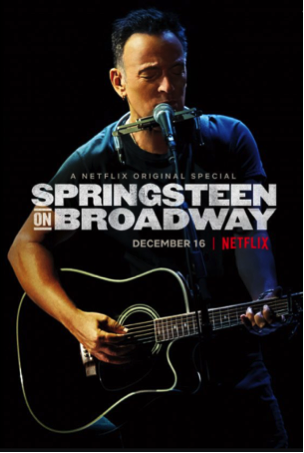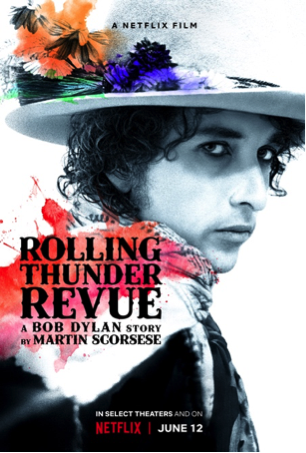Television Review: Rolling Thunder Revue: A Bob Dylan Story and Springsteen on Broadway
Bernie Langs
Photo Credits: Netflix
If one believes that we’re living in a golden age of television, that blessing comes with a bonus of a golden age of rock and roll documentaries. Recent superlative films airing on Netflix and other cable services include full-length features about Keith Richards, John Lennon, Eric Clapton, and George Harrison, with an emphasis on new interviews with the primary subject (unless deceased), as well as many musicians who retell their stories as witnesses to the life and era in question.
Two new documentaries have left me with an increased appreciation and respect for the featured artists. Martin Scorsese’s film about the mid-1970s Rolling Thunder Revue tour of Bob Dylan is anchored throughout by a rare discussion with Dylan today. The second is the Netflix feature of Bruce Springsteen’s Broadway show, which was a sell-out hit during its limited run. The contemporary Dylan interviewed by Martin Scorsese is insightful, intelligent, humorous, and energetic, defying his late 70s age at the time of filming. Springsteen appears bright, witty, and deeply introspective as he relates the story of his life and career without pause and with biting emotional intensity.
In Springsteen on Broadway, the artist undertakes a live performance of his recent autobiography, Born to Run. Springsteen strums a solo guitar or plays the piano while recollecting and diving deep into the key events of his life and successful years in the world of music. It is unlike any Broadway show I’ve ever seen, a unique journey of the heart and soul.
Springsteen has a physical appearance akin to a chiseled stone monument, a weathered journeyman who has risen to peaks of success and heights of uncompromising integrity. Yet the artist has been felled at times by his depressive inner demons, many stemming from decades of confusion about his relationship with his tough, emotionally-stunted, hard-drinking father. Springsteen’s confessions are so raw, open, revealing, and, at times, brutal that I could only watch the documentary in short segments over several weeks. Springsteen’s wife, Patti Scialfa, joins him onstage to perform at times during the show, a respite from the rough ride we’ve been witnessing.
Springsteen rolls through versions of many of his hits, including “Thunder Road,” “Growin’ Up,” and “Born in the USA,” and supplements the music with a wide range of discussions. He speaks at length about how his long-time sax player and stage foil, the late Clarence Clemons, burst into his life and remained an overwhelming vital force throughout their many years together. The void created from Clemons’s death has been a great one for Springsteen, one with which he continues to struggle.
As an artist, Springsteen has a unique mind and a sharp view of the America in which we live today. His autobiography, the basis of the Broadway show, is an exciting read and a vivid display of literary rock and roll reminiscing. During the show, the stories about his father include the tale of how he had brought him to one concert to make his father see that his rock star son’s entire stage and musical persona as a working class man dressed in factory attire was based not on his own experiences but is borrowed from his dad. This manipulation was used by Springsteen to make an artistic statement, which was the key to his success.
More than any top director of major artistic films, Martin Scorsese is a musician’s filmmaker. He cut his teeth working on the Woodstock documentary and his early movies are peppered with well-placed rock and roll classics. His music documentaries include studies of George Harrison’s life, Living in the Material World, and the final performance of The Band in The Last Waltz. His new feature, Rolling Thunder Revue: A Bob Dylan Story studies the artist’s enigmatic mid-1970s wandering, troubadour-like tour, with its free spirit and great musical intensity. The new interviews with Dylan are focused and revealing, and one delights in the sing-song cadence of his spoken word. Dylan is the epitome of a vastly creative, genius poet well deserving of his Nobel Prize in Literature.
In one of Dylan’s first scenes, he asks Scorsese to halt filming as he attempts to get a handle on recalling the tour that took place decades ago. He humorously claims not to remember one thing about Rolling Thunder Revue and notes, “I wasn’t even born yet!,” a notion that makes complete sense in that this Bob Dylan is absolutely not the man we see speaking and singing in the 1970s footage. In the same segment, Dylan notes that his life has been centered around the act of creating, nothing more and nothing less, a remarkably astute sentiment.
There were many great artists that bounced in and out of the line-up of Rolling Thunder Revue, including Roger McGuinn of The Byrds and the late Mick Ronson, the guitar virtuoso who helped propel David Bowie to fame. The footage of the legendary Ronson soloing with the band are a highlight of the movie. One interviewee claims that Ronson told him at the time he had no idea what Dylan thought of him and that Dylan had never spoken to him during the tour. Yet there is a moment captured in the movie when Dylan stands before Ronson, rocking back and forth in a bliss-like state as the guitarist riffs with powerful intensity.
My favorite moment in Rolling Thunder is when Joni Mitchell, who joined the performers late in the tour, is in a back room with Dylan and Roger McGuinn teaching them her newly-penned song “Coyote,” which went on to become a classic (and which is also featured in Scorsese’s Last Waltz). When Mitchell begins singing this fantastic tune, we once again understand her status as one of the most respected artists in popular music. It’s a sublime moment in rock and roll history, captured on film in this one-time, unrehearsed, spur-of-the-moment performance with three legends.
The 1970s Dylan and the man we see on film today seems honest and genuine, nothing like the cunning, cultural manipulator described by the over-imaginative rock press through the years. He loves music and appreciates his musicians and it is obvious he is enjoying the tour. Funny enough, Dylan also drives the entourage’s large tour bus, the sight of which is oddly surreal. Perhaps he took the wheel because it offered the best and widest view of the scenery, a front seat vantage from which to take in America as they ride the open roads and swing into towns and cities.
Scorsese has chosen wisely from the many works performed during the Rolling Thunder Revue. We see some of the most moving songs by the artist from his mid-70s catalogue and hear several from his earlier days. There is a powerful version of “A Hard Rain’s A-Gonna Fall,” an emotionally meditative “One More Cup of Coffee (Valley Below),” and a searing rendition of “Isis.” “Isis” was on Dylan’s 1976 album, Desire. It is a power-packed story of love and the seeking of earthly fortune. Dylan sings as a wide-eyed, energetic narrator with his face painted Kabuki white. It invites the listener to dream of cinematic action and adventure.
I believe that the present-day music industry has struggled to produce consistently high quality music on par with the excellence we are experiencing today in movies and television shows. But I’ll take it as a win that I find such deep satisfaction from a new documentary about a Dylan tour from a long past era or by watching Springsteen onstage in a Broadway show expounding with deep emotionality the tales of his older catalogue as it relates to his personal life. I consider these two films a huge validation for the continued relevancy of rock and roll, the music that acts as the powerful soundtrack for so many lives, including my own.


